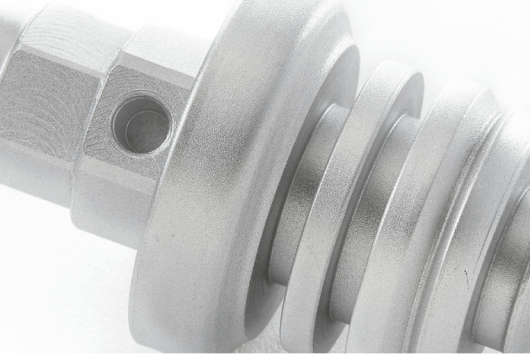
CNC Turning Service
Get quality custom turned parts for rapid prototyping and end-use production. Lead times are as fast as 1 day.
Certifications ISO 9001:2015 | AS9100D | ITAR





Jump to Section
→ Capabilities
→ Materials
→ Surface Finishes
→ About CNC Turning
Our CNC turning process produces custom prototypes and end-use production parts in as fast as 1 day. We use a CNC lathe with live tooling so features like axial and radial holes, flats, grooves, and slots can be machined.
CNC turning is often used for:
- functional prototypes and end-use parts
- parts with cylindrical features
- parts with axial and radial holes, flats, grooves, and slots

Design Guidelines for CNC Turning
Our basic guidelines for CNC turning include important design considerations to help improve part manufacturability, enhance cosmetic appearance, and reduce overall production time.
| US | Metric | ||
| Maximum Dimensions | Diameter | 3.95 in. | 100.33mm |
| Length | 9 in. | 228.6mm | |
| Minimum Dimensions | Diameter | 0.16 in. | 4.07mm |
| Length | 0.05 in. | 1.27mm | |
| Wall Thickness | 0.020 in. | 0.51mm | |
| Angle | 30° | 30° | |
| Tolerances | +/- 0.005 in. | +/- 0.13mm | |
Additional Notes on CNC Turning Guidelines
- Small features may be allowed, but the diameter in any region should not be less than 0.030 in. (0.76mm).
- Sharp conical points are allowed; angles should be greater than 30 degrees. Walls thinner than 0.020 in. (0.5mm) typically do not survive the machining process.
Materials for CNC Turning
We stock a range of metal materials that are suitable for various part applications and industries. Choose from aluminum, brass, low carbon steel, stainless steel, steel alloy, and titanium for turned parts.
- Aluminum
- Brass
- Low Carbon Steel
- Steel Alloy
- Stainless Steel
- Titanium

Surface Finish Options for Turned Parts
Parts that are turned typically have a very smooth surface finish. The as-machined surface finish of the cylindrical areas will typically be much smoother using the lathe than the mill, so consider this when selecting the machining method for those parts that qualify for either method. Areas cut with live tooling, such as flats and slots, may have visible tools marks.
If desired, the metal parts can be lightly bead blasted leaving a fine matte finish. Hard metals like steel and stainless steel can also have edges broken (deburred) with a light bead blast to remove metal slivers, and sharp or rough areas.
| Aluminum | Edges broken with visible toolmarks, edges broken with light bead blast, or sharp edges with visible toolmarks |
|---|---|
| All other metals | Edges broken with visible toolmarks or edges broken with light bead blast |

Material: Aluminum
Surface Finish: Broken Edge

Material: Aluminum
Surface Finish: Bead Blast

Material: Aluminum
Surface Finish: Sharp Edge
Anodizing and Chromate Plating Specifications
| Anodize | Hard Anodize | Chromate |
|---|---|---|
|
MIL-A-8625 Type II, Class 2 (Blk) MIL-A-8625 Type II, Class 1(Clr) |
MIL-A-8625 Type III, Class 2 (Blk) | MIL-DTL-5541 Type II, Class 3 (Clr) |
Quick-turn Finishing
Here are the requirements to get parts in as fast as 4 days (1-day expedite + 3 days for plating):
High-requirement Finishing
Have AS9100 and ITAR requirements? Try our domestic precision machining option. If you have more complex anodizing and plating requirements, work with our digital network of manufacturers. The network works well for components that require a specialized color or material option such as titanium or nickel.
What is CNC Turning?
CNC turning is a subtractive manufacturing process that rotates a metal rod while a cutting tool is held against the stock to remove material and create final parts. Our CNC lathes are also equipped with live tooling that can machine flat features and holes into the workpiece. Outside diameter (OD) and inside diameter (ID) threading is also available.
Turned parts can then be left as-machined, with visible tool marks, or bead blasted. When the run is complete, parts are inspected, boxed and shipped shortly thereafter.











